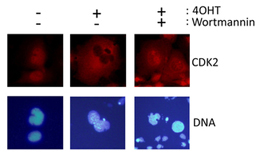Research Abstract
CSN5はCDK2と特異的に相互作用し、細胞質のサイクリンEを介して老化を制御する
CSN5 specifically interacts with CDK2 and controls senescence in a cytoplasmic cyclin E-mediated manner
2013年1月11日 Scientific Reports 3 : 1054 doi: 10.1038/srep01054

哺乳類COP9シグナロソーム(CSN)複合体の第5構成因子(CSN5)は、細胞の増殖と老化に必須の役割を担っているが、その仲介分子は明らかになっていない。本研究では、さまざまな細胞周期制御因子の中から相互作用因子を探索し、CSN5がCSN複合体とは関係なくin vivoとin vitroにおいてCDK2と結合することを見いだした。CSN5を減少させると、AktによるCDK2のリン酸化が亢進し、レプトマイシンB耐性的にCDK2とそのパートナーであるサイクリンEが細胞質に蓄積して、retinoblastomaタンパク質のリン酸化が阻害された。CSN5欠損細胞でさらにCDK2をノックダウンすると、サイクリンEの発現が正常レベルに復帰し、細胞老化が抑制された。また、不死化した細胞株に細胞質局在サイクリンEを強制的に発現させると細胞老化を誘導した。以上の結果は、CSN5がCDK2を介して、細胞質サイクリンEに依存した新規の細胞老化制御において機能することを示している。
吉田 晃洋1, 加藤 規子1 & 加藤 順也1
- 奈良先端科学技術大学院大学 バイオサイエンス研究科 腫瘍細胞生物学研究室
The fifth component (CSN5) of the mammalian COP9 signalosome complex plays an essential role in cell proliferation and senescence, but its molecular mediator remains to be determined. Here, we searched for interactors among various cell cycle regulators, and found that CSN5, but not the CSN holo-complex, bound to CDK2 in vivo and in vitro. Depletion of CSN5 enhanced phosphorylation of CDK2 by Akt, resulting in cytoplasmic accumulation of CDK2 together with cyclin E in a leptomycin B-resistant manner, and impaired phosphorylation of the retinoblastoma protein. Additional knockdown of CDK2, which reduced the expression of cyclin E to the normal level, did not restore cell proliferation, but significantly suppressed senescence in CSN5-depleted cells. Enforced expression of cytoplasmic cyclin E induced premature senescence in immortalized cell lines. These results show that CSN5 functions through CDK2 to control premature senescence in a novel way, depending on cyclin E in the cytoplasm.

